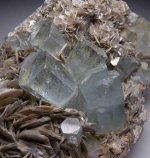Having read this entire thread, as I'm about to embark on my first Class A amp - A Pass F5, am I right in concluding that my choices for 4 tiny devices on 2 massive heatsinks should be:
Keratherm with no paste:
Wärmeleitfolie Keratherm® - Rot 86/82 Kerafol 86/82 (L x B) 190 mm x 190 mm Stärke 0.25 mm 6.5 W/mK im Conrad Online Shop | 189058
Berylium oxide (also very good, but toxic if powdered) with silicon grease.
Aluminium Oxide with silicon grease.
Mica and silicon grease.
- I have polished my mosfets
- I have polished my sinks (Conrad MF35 - 151.5)
- I have Mica, ranging from 0.1mm to 0.02mm, but I'd prefer something more effective as it makes such a big difference for the small outlay.
Thanks in advance.
Keratherm with no paste:
Wärmeleitfolie Keratherm® - Rot 86/82 Kerafol 86/82 (L x B) 190 mm x 190 mm Stärke 0.25 mm 6.5 W/mK im Conrad Online Shop | 189058
Berylium oxide (also very good, but toxic if powdered) with silicon grease.
Aluminium Oxide with silicon grease.
Mica and silicon grease.
- I have polished my mosfets
- I have polished my sinks (Conrad MF35 - 151.5)
- I have Mica, ranging from 0.1mm to 0.02mm, but I'd prefer something more effective as it makes such a big difference for the small outlay.
Thanks in advance.
Thanks Andrew. It came in at 0.1mm thickness, but certain pieces delaminate quite cleanly to reveal much thinner slices. I am a tad worried that such thin pieces might be vulnerable to shorting, and as I'm building an F5 with no thermal protection or current limiting, I guess that's all the more reason to make doubly sure I have excellent heat dissipation and protection from all kinds of short circuit.
Wouldn't Keratherm be worth the modest investment, in your view?
Wouldn't Keratherm be worth the modest investment, in your view?
I doubt Mica would short out unless you damage it while trying to peel it apart.
Zhoufang had Keratherm pieces for $1 each.
Zhoufang had Keratherm pieces for $1 each.
I emailed the distributor and obtained a sample piece of Kerafol 86/83, and it does the job very well. Hopefully I'll never go back to mica and goop...
Locas,
I suggest you add a DC Protection module on the O/P - better to be safe than sorry, particularly if using expensive speakers
I suggest you add a DC Protection module on the O/P - better to be safe than sorry, particularly if using expensive speakers
Well, 1973 Celestion 44s with £30 Seas tweeters and rebuilt Xovers. Drivers replaceable for £100 for a full set, I should think. I may well take my chances with nothing at all. I will be using Neutrik connectors to defend against short circuit, and I'll be careful to fine tune the DC offset. Thanks for your concern though. You certainly do talk sense.
My favorite mounting is with the hard anodized aluminum insulators and Aavid phase change compound on both surfaces. I doubt there's much better, but I don't know about the long term (decades) performance of the phase change compound, as it goes liquid when hot. That's why it works so well- near zero thickness if the surfaces are flat.
I'm not officially recommending it, but you would be surprised how many
prototypes I've built with grease and just the anodizing on the sinks.
😎
prototypes I've built with grease and just the anodizing on the sinks.
😎
I'm also just using the anodizing and grease on my new Semisouth BA-1 monoblocks, but was afraid I may get booted out of the forums for mentioning that.
Fearless Amp Burner.
(Me chicken-S, only did that with same sex devices on one heatsink. On plastic stand-offs, inside the case)
(Me chicken-S, only did that with same sex devices on one heatsink. On plastic stand-offs, inside the case)
The old Carvin FET900 didn't use insulators either but that amp had plenty of other problems to worry about.
Craig
Craig
I know Silpads and Phase Linear amps don't make nice music, causes them to oscillate. In fact it's the service manual to remove them if you come across them. I tried Silpads on an old Quatre amp ( NOT the Gain Cell model) and had all kinds of problems, put good old mica and goop back in and the problems went away. Both those amps use TO-3 xsistors.
Craig
Craig
Tell me, since I've become OCD obsessed with delaminating 0.1mm mica washers into thinner pieces with a scalpel: is undamaged 0.01mm of mica (one hundredth of a mm) capable of insulating mosfets at ±45 degrees for years without degradation and failure, or should I go a tad thicker? What thickness do you all use? I'm figuring that this element of a class a amp is easily as vital as any fancy component choice.
- Home
- Amplifiers
- Pass Labs
- Mica and Goop

